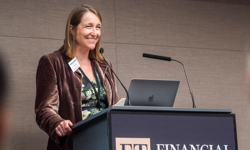
In the age of fake news, how do you educate young people about where to find trusted sources of information? That is the question at the heart of the Financial Times’ Schools Programme, which makes the newspaper’s content available free of charge to 16 to 19-year-olds and is now in its third year.
Andrew Jack, the FT’s global education editor, explains: “It begins with a philosophy around the importance of high level journalism and developing a next generation that is well informed. At the time of growing concerns about fake news, we want to be a counterbalance to that. There is also of course a desire to make a new generation familiar with the FT. There isn’t a direct connection to future subscribers but a hope that over time, some of them might become readers of the FT. They are more likely to become and remain loyal, but also to think about where the credible places are to go for information.”

Jack admits the FT came under pressure from a student who argued that they should lift the paywall for this age group.
“We were thinking about how we get a younger audience for our news and current affairs. We had a rather vocal sixth former who was making the case, surely you can make it accessible to me and my peers. The simplest solution seemed to be, let’s use our core content, encouraging them to stretch towards it. Let’s lift the paywall because this is a group who wouldn’t be natural FT readers. We’d never be cannibalising our business model,” says Jack.
First of all, a school administrator needs to register with the FT, so they can check it is a genuine school. Then they lift the paywall at that IP address, allowing the school to create individual accounts for students and teachers. The first schools to sign up were in the UK, but the media brand has now extended the programme around the globe.
Jack says: “We’ve got tens of thousands of weekly readers and engagements from the schools community. We are in a very high proportion of UK schools with a sixth form and in hundreds of countries around the world: the US, mainland Europe, Australia, New Zealand. It really does go from Afghanistan to Zimbabwe and picks up continually.”
It begins with a philosophy around the importance of high level journalism and developing a next generation that is well informed.
Easing timetable pressures
Today’s 16 to 19-year-olds are under intense time pressure, so the FT relies on teachers to curate the articles that are best suited to the curriculum.
“With that age group, there is a lot of pressure on the timetable, so the more we can align with their interests the better. We have a network of teachers who flag up content in different areas and provide discussion points. It’s a conversation starter in economics, business and politics, a network of articles curated by the teachers themselves that then can be shared peer to peer, real world examples of what they’ve been learning in the textbooks,” explains Jack.
The FT uses this input from teachers to create weekly “classes” in economics, geography, politics and business, drawing on its existing online archive of articles.
Competitions are another important feature of the programme. These include a schools’ blog competition as well as a recent competition for Young Personal Finance Journalist organised by the London Institute of Banking and Finance in conjunction with the FT to find the best personal finance articles by people aged 14 to 19. The winners receive a cash prize of £150 each, as well as the opportunity to see their work in print. The questions they were asked to address included: ‘What are the main financial issues facing young people today?’, ‘Why should young people consider a career in banking and finance?’, ‘Personal Data is the new gold. Discuss’ and ‘How can the finance sector help us move towards lower carbon economies and mitigate the impacts of climate change?’
Jack says: “The winning essays get published, which is great for the students and also gives our older audience access to insights from the next generation. They can use it to put on their CVs or personal statements. We are really building up the range of ways in which we can add value.”
We’ve got tens of thousands of weekly readers and engagements from the schools community.
Watch & listen
Given the importance of video to this age group, the brand has launched an FT Schools YouTube channel, featuring young people’s voices, as well as guiding students towards its existing video content.
Jack says: “Video is something which appeals across the ages, but particularly that age group engages with it a lot. There are a couple of areas where I think there is a gap in the market which we can fill. Firstly, financial literacy, given our background and expertise, and also the demand and need in that generation to understand finance. Secondly, that school to work transition. We periodically make short videos with younger voices about how to apply to university or do an interview.”
Audio is another growth area for the younger generation, where the FT makes use of its existing content. Jack says: “In podcasts, we’ve not done specific ones for schools, but we try to showcase the wealth of podcasts we do, rather than try to reinvent the wheel.”
When it comes to social media, the programme is currently more focused on connecting with teachers than students: “It’s an area we are certainly trying to explore. Our Twitter feed is more focused on teachers. Really, the idea is to try to reduce the friction and to engage through whatever channels, so teachers can see what’s being done and share content and reactions to it,” says Jack.
Playing games
Last autumn, the FT launched Road to Riches, a new board game aimed at secondary school pupils, which aims to boost financial literacy, in collaboration with Eliora Games. The game was the joint brainchild of former FT intern and Manchester University student Krishan Puvvada and economist and games designer Mario Fischel. They wanted to create a way for young people to learn about money and investing. FT registered schools can apply to be sent the game for free.

Jack explains: “We worked with a third-party games developer who had already developed a board game and they developed a new variant of it aimed at the sixth form generation trying to embed the key learnings: understanding about student loans, investment savings, pension and how broad economic trends can influence the outcomes. Financial literacy is something students and teachers are keen to do more around.”
Puvvada, who worked on the game with World Bank economist Mario Fischel, said: “Leading the FT Schools initiative on my gap year confirmed that students around the world are concerned about managing money when they leave school and feel that existing personal finance education is inadequate and mundane. Not everyone is fortunate enough to have family members who can teach them how to make better financial decisions. It’s a real problem. The object is to make discussions about money fun and exciting. Surprisingly, not one student looked at their phone during the testing. They were all completely immersed and invigorated by this old-fashioned concept of a board game.”
Financial literacy is something students and teachers are keen to do more around.
Content mix
Jack believes that today’s students are open to receiving information in a variety of forms, whether that is video, audio, or the more traditional print article.
He says: “There’s a retro appeal to the physical form. Some teachers will print out FT articles. That reflects different learning styles. I’ve seen students scrapbook in different ways to process information. To me, the great pleasure in visiting schools has been to see the variety of ways in which the content is used and the level of engagement with it. You do feel it’s making a valuable difference.”
Gavin Clarke, head of economics at Emmanuel College in Gateshead, an FT-registered school, which was involved with testing the prototype of the Road to Riches game, agrees: “We were one of the first schools to sign up and have been going at this since 2017. In my view, the FT represents some of the best journalism that students could wish to be exposed to. It was a no-brainer. Literacy was also a major buzz word in education at that time, so it made sense.”
Around 80 of Clarke’s students at Emmanuel College regularly read articles which he has specified for them, with others dipping into the FT’s content on a more ad hoc basis. Andrew Jack also hosted some of the school’s economics and politics students on a recent trip to London. Clarke says the students find particularly useful the questions set by the FT’s weekly Economics Class.
He says: “It helps to develop their world view as well as developing critical thinking as they are required to evaluate opinions which often differ from their own. When it comes to UCAS applications and interviews, it is useful for students to be able to cite a regular reading habit outside of the taught curriculum. One of my pupils even opened a Help-to-Buy ISA after reading an FT article about it.”
Jack concludes: “Judging by the continual growth of the programme and lots of informal feedback, this is definitely an important, growing and valuable service. There’s an appetite for high value journalism in teachers and students around the world. The value of getting them to stretch to us and using digital as primary means of transition does mean we can get into a lot more places. There’s been a large amount of goodwill and interest. It’s a chunk of my time and a chunk of other people’s, fellow journalists, interns, colleagues on the IT side. You can achieve quite a lot with not a huge amount.”
This article was first published in InPublishing magazine. If you would like to be added to the free mailing list, please register here.












